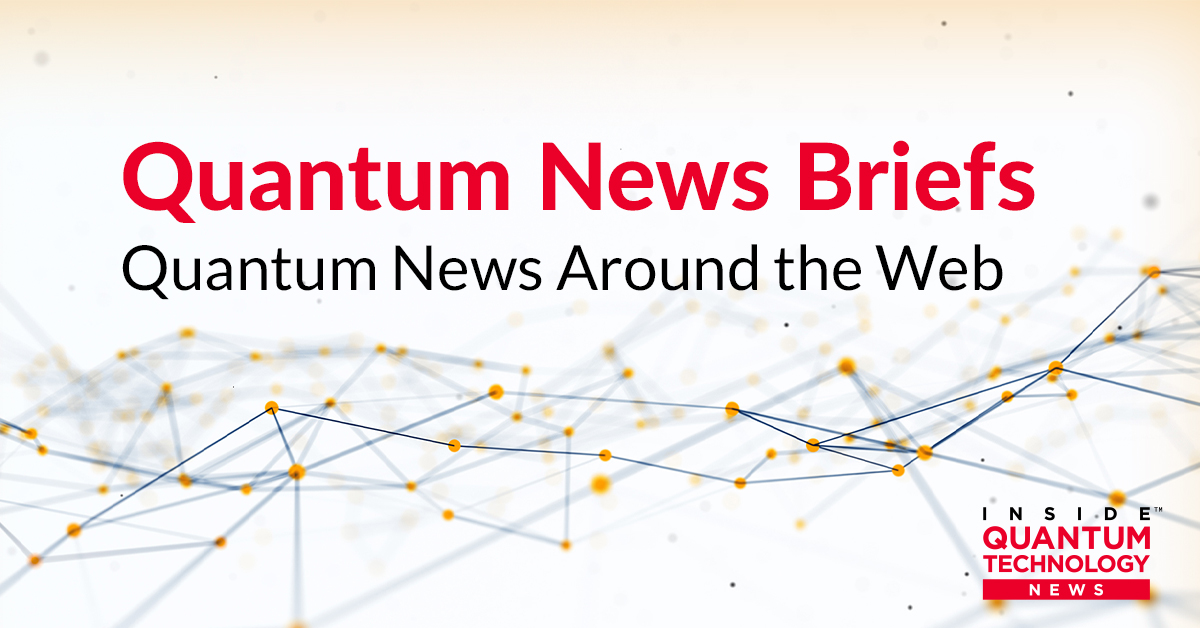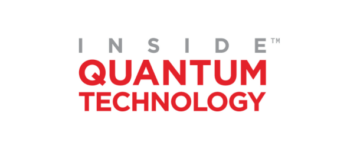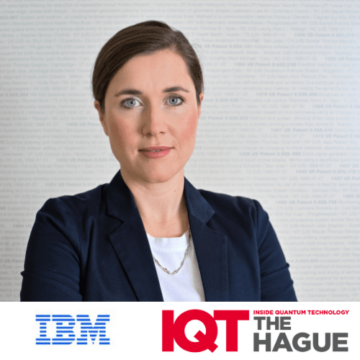
Quantum News Briefs October 13 Quantum Machine Learning to progress in 2023; IBM announces $725M quantum computing deal with Australian government; New industry-academia research collaboration for responsible quantum computing announced between Responsible Technology Institute & Quantum Computing & Simulation Hub + MORE
*****
Quantum Machine Learning to progress in 2023

Sri Krishna is the author of a January 12 VentureBeat article discussing the advancement of quantum machine learning (QML) in 2023. The article is rich with interviews and includes perspectives from industry, academia, and finance; Quantum News Briefs summarizes below.
QML combines the power of quantum computing with the predictive capabilities of ML to overcome the limitations of classical algorithms and offer improvements in performance. In their paper “On the role of entanglement in quantum-computational speed-up,” Richard Jozsa and Neil Linden, of the University of Bristol in the UK, write that “QML algorithms hold the promise of providing exponential speed-ups over their classical counterparts for certain tasks, such as data classification, feature selection and cluster analysis. In particular, the use of quantum algorithms for supervised and unsupervised learning has the potential to revolutionize machine learning and artificial intelligence.”
Research on quantum machine learning began in the 1980s. In the late 1990s and early 2000s researchers developed quantum neural networks to demonstrate the potential of quantum systems for machine learning that can be trained to recognize patterns in data. These networks have since been applied to a wide range of real-world problems. By the 2020s, QML began to be widely adopted in applications including pattern recognition, natural language processing and optimization.
Zohra Ladra, senior director, data science and AI at Tredence, says QML differs from traditional machine learning in several key ways: 1. Quantum parallelism; 2. Quantum superposition; and 3. Quantum entanglement. Traditional machine learning algorithms lack these quantum capabilities.
Today, one of the most promising applications of QML is drug discovery. QML has the potential to accelerate the traditional, lengthy process. “After our initial success in finding a COVID-19 therapeutic molecule, we wanted to extend the space to now generate smaller molecules,” said Nikhil Malhotra, global head, Makers Lab at Tech Mahindra.
Financial markets are another area where QML has shown promise. A 2021 paper from JPMorgan’s Future Lab for Applied Research and Engineering concluded that QML can perform tasks such as asset pricing, predicting volatility, predicting the outcome of exotic options, fraud detection, stock selection, hedge fund selection, algorithmic trading, market making, financial forecasting, accounting and auditing, and risk assessment much faster and more accurately than classical algorithms.
Scott Buchholz, global quantum lead and CTO, government and public services, Deloitte Consulting LLP, said in concluding paragraph, “….we are continuing to advance the state of the art in QML as the hardware continues to improve. But I anticipate incremental QML progress throughout 2023 — that is, continuing to improve the techniques to scale volume, load data and run models.” Click here to read the VentureBeat article in-entirety.
*****
IBM announces $725M quantum computing deal with Australian government
 IBM Australia has announced the signing of the next iteration of the Whole-of-Government Arrangement with the Digital Transformation Agency (DTA) on behalf of the Commonwealth of Australia. Quantum News Briefs summarizes the January 12 announcement.
IBM Australia has announced the signing of the next iteration of the Whole-of-Government Arrangement with the Digital Transformation Agency (DTA) on behalf of the Commonwealth of Australia. Quantum News Briefs summarizes the January 12 announcement.
Under this arrangement, IBM Australia will continue to help the Australian government drive accelerated adoption of innovative technology to modernize government services for Australians. q
All government agencies will continue to have access to IBM technology and benefit from the cost efficiencies driven by the economies of scale built into the new arrangement. For the major agencies that partner with IBM – the Australian Taxation Office, Department of Defence, Department of Home Affairs and Services Australia – the new arrangement will continue to provide them with autonomy to accelerate the deployment of technology that aligns with their individual agency priorities and needs.
Quantum computing has the potential to tackle some of the hardest computational challenges across sectors that today’s most-powerful classical supercomputers cannot solve and never will. IBM has a long history of advancing quantum computing technology and brings decades of research to the quantum computing industry — from theory to the entire technology stack. This work has positioned IBM as a quantum industry leader, with unmatched accessibility and resources via the globe’s largest fleet of quantum computers available through the cloud. The arrangement with the DTA will enable government agencies to work with IBM to explore how quantum technology could be applied by government agencies to explore the applicability of quantum computing to some of their most challenging problems.
Under the new arrangement, IBM will work with the Australian Government to help grow the digital capability of the APS through providing access to an IBM Digital Skills Program that will bring global learnings to public sector executives. This will help enable executives to discover and co-envision scalable, sustainable Australian approaches to create an APS that is future-proof and ready to support Australians for generations to come. Click here to read the complete announcement.
*****
New industry-academia research collaboration for responsible quantum computing announced between Responsible Technology Institute & Quantum Computing & Simulation Hub

The Responsible Technology Institute (RTI) has announced a new research collaboration with the Quantum Computing and Simulation Hub (QCS), and EY. Quantum News Briefs summarizes the January 12 announcement.
Although significant progress has been made in quantum computing in recent years, there are many engineering challenges that remain before the commercialization of the technology is a reality. Despite these challenges, it is the right time for the quantum computing community to engage with industry and with society on the technology’s implications. This is necessary in order to ensure that society experiences not only the benefits of advanced quantum computing research, but also that principles of good governance, transparency and other aspects of responsible development are translated from the research environment into the commercial sector.
The ResQCCom project (Responsible Quantum Computing Communications) will focus on engaging with industry, with policymakers, and with the general public, to discuss how quantum computing may affect society and how to prepare for this.
The project is being led by Professor Marina Jirotka, Professor of Human-Centred Computing and Director of the RTI, who commented, “The rate of progress in quantum computing has accelerated enormously in recent years, and the industrial sector is rapidly becoming more developed. As potential use-cases become clearer, the importance of preparing for and anticipating its effects becomes more urgent.” Click here to read complete announcement on RTI’s website.
****

Australian engineers have discovered a new way of precisely controlling single electrons nestled in quantum dots that run logic gates. What’s more, the new mechanism is less bulky and requires fewer parts, which could prove essential to making large-scale silicon quantum computers a reality. Quantum News Briefs summarizes the Phys.org coverage.
The serendipitous discovery, made by engineers at the quantum computing start-up Diraq and UNSW Sydney, is detailed in the journal Nature Nanotechnology.
“This was a completely new effect we’d never seen before, which we didn’t quite understand at first,” said lead author Dr. Will Gilbert, a quantum processor engineer at Diraq, a UNSW spin-off company based at its Sydney campus. “But it quickly became clear that this was a powerful new way of controlling spins in a quantum dot. And that was super exciting.”
“This is a new way to manipulate qubits, and it’s less bulky to build—you don’t need to fabricate cobalt micro-magnets or an antenna right next to the qubits to generate the control effect,” said Gilbert. “It removes the requirement of placing extra structures around each gate. So, there’s less clutter.”
Controlling single electrons without disturbing others nearby is essential for quantum information processing in silicon. There are two established methods: “electron spin resonance” (ESR) using an on-chip microwave antenna; and electric dipole spin resonance (EDSR), which relies on an induced gradient magnetic field. The newly discovered technique is known as “intrinsic spin-orbit EDSR.” Click here to read the Phys.org article in-entirety.
*****
Sandra K. Helsel, Ph.D. has been researching and reporting on frontier technologies since 1990. She has her Ph.D. from the University of Arizona.
- SEO Powered Content & PR Distribution. Get Amplified Today.
- Platoblockchain. Web3 Metaverse Intelligence. Knowledge Amplified. Access Here.
- Source: https://www.insidequantumtechnology.com/news-archive/quantum-news-briefs-january-13-quantum-machine-learning-to-progress-in-2023-ibm-announces-725m-quantum-computing-deal-with-australian-government-new-industry-academia-research-collaboration-announ/
- 1
- 2021
- 2023
- a
- AC
- Academia
- accelerate
- accelerated
- access
- accessibility
- Accounting
- accurately
- across
- adopted
- Adoption
- advance
- advanced
- affect
- agencies
- agency
- AI
- algorithmic
- algorithmic trading
- algorithms
- Aligns
- analysis
- and
- announced
- Announcement
- Announces
- Another
- antenna
- anticipate
- anticipating
- applications
- applied
- approaches
- AREA
- arizona
- around
- arrangement
- Art
- article
- artificial
- artificial intelligence
- aspects
- assessment
- asset
- auditing
- Australia
- Australian
- author
- available
- based
- become
- becomes
- becoming
- before
- began
- being
- below
- benefit
- benefits
- between
- bring
- Brings
- bristol
- built
- Campus
- cannot
- capabilities
- certain
- challenges
- challenging
- classification
- clear
- clearer
- Cloud
- Cluster
- clutter
- collaboration
- combines
- come
- commented
- commercial
- commercialization
- commonwealth
- Communications
- community
- company
- complete
- completely
- computers
- computing
- computing research
- concluded
- consulting
- continue
- continues
- continuing
- control
- controlling
- Cost
- could
- COVID-19
- create
- CTO
- data
- data science
- deal
- decades
- defence
- deloitte
- demonstrate
- Department
- deployment
- Despite
- detailed
- Detection
- developed
- Development
- digital
- Digital Transformation
- Director
- discover
- discovered
- discovery
- discuss
- discussing
- Dont
- DOT
- drive
- driven
- drug
- drug discovery
- each
- Early
- economies
- Economies of Scale
- effect
- effects
- efficiencies
- Electric
- electrons
- enable
- engage
- engaging
- engineer
- Engineering
- Engineers
- enormously
- ensure
- Entire
- Environment
- essential
- established
- Ether (ETH)
- exciting
- executives
- Exotic
- Experiences
- explore
- exponential
- extend
- extra
- EY
- faster
- Feature
- field
- finance
- financial
- finding
- First
- FLEET
- Focus
- fraud
- fraud detection
- from
- Frontier
- fund
- future
- Gates
- General
- general public
- generate
- generations
- Global
- good
- governance
- Government
- Grow
- Hardware
- head
- hedge
- hedge fund
- help
- here
- history
- hold
- Home
- How
- How To
- HTML
- HTTPS
- Hub
- IBM
- image
- implications
- importance
- improve
- improvements
- in
- includes
- Including
- individual
- industrial
- industry
- industry Leader
- information
- initial
- innovative
- Institute
- Intelligence
- Interviews
- IT
- iteration
- Jan
- January
- journal
- Key
- known
- lab
- Lack
- language
- large-scale
- largest
- Late
- lead
- leader
- learning
- Led
- limitations
- LLP
- load
- Long
- machine
- machine learning
- made
- Magnetic field
- major
- Makers
- Making
- many
- Market
- market-making
- Markets
- max-width
- mechanism
- methods
- ML
- models
- modernize
- molecule
- more
- most
- Natural
- Natural Language
- Natural Language Processing
- necessary
- Need
- needs
- networks
- Neural
- neural networks
- New
- news
- next
- october
- offer
- Office
- ONE
- optimization
- Options
- order
- Other
- Others
- Overcome
- Paper
- particular
- partner
- parts
- Pattern
- patterns
- perform
- performance
- perspectives
- placing
- plato
- Plato Data Intelligence
- PlatoData
- policymakers
- positioned
- posted
- potential
- power
- powerful
- precisely
- predicting
- Prepare
- preparing
- pricing
- principles
- problems
- process
- processing
- Processor
- Professor
- Program
- Progress
- project
- promise
- promising
- Prove
- provide
- providing
- public
- Quantum
- quantum algorithms
- quantum computers
- quantum computing
- Quantum dot
- Quantum dots
- quantum entanglement
- quantum information
- quantum machine learning
- quantum superposition
- quantum systems
- quantum technology
- qubits
- quickly
- range
- rapidly
- Rate
- Read
- ready
- real world
- Reality
- recent
- recognition
- recognize
- remain
- Reporting
- requirement
- requires
- research
- researchers
- resonance
- Resources
- responsible
- revolutionize
- Rich
- Richard
- Risk
- risk assessment
- Role
- RTI
- Run
- Said
- scalable
- Scale
- Science
- sector
- Sectors
- selection
- senior
- Services
- several
- shown
- significant
- signing
- Silicon
- simulation
- since
- single
- skills
- smaller
- So
- Society
- SOLVE
- some
- Space
- Spin
- spins
- stack
- Start-up
- State
- stock
- success
- such
- Super
- supercomputers
- superposition
- support
- sustainable
- sydney
- Systems
- tasks
- Taxation
- tech
- Tech Mahindra
- techniques
- Technology
- The
- The State
- the UK
- their
- Therapeutic
- Through
- throughout
- time
- to
- today’s
- Trading
- traditional
- trained
- Transformation
- Transparency
- true
- Uk
- understand
- university
- unmatched
- unsupervised learning
- urgent
- use
- use-cases
- VentureBeat
- via
- Volatility
- volume
- wanted
- ways
- Website
- which
- WHO
- wide
- Wide range
- widely
- will
- without
- Work
- write
- years
- zephyrnet












